Search Results for Triceratops
Explore AI generated designs, images, art and prompts by top community artists and designers.
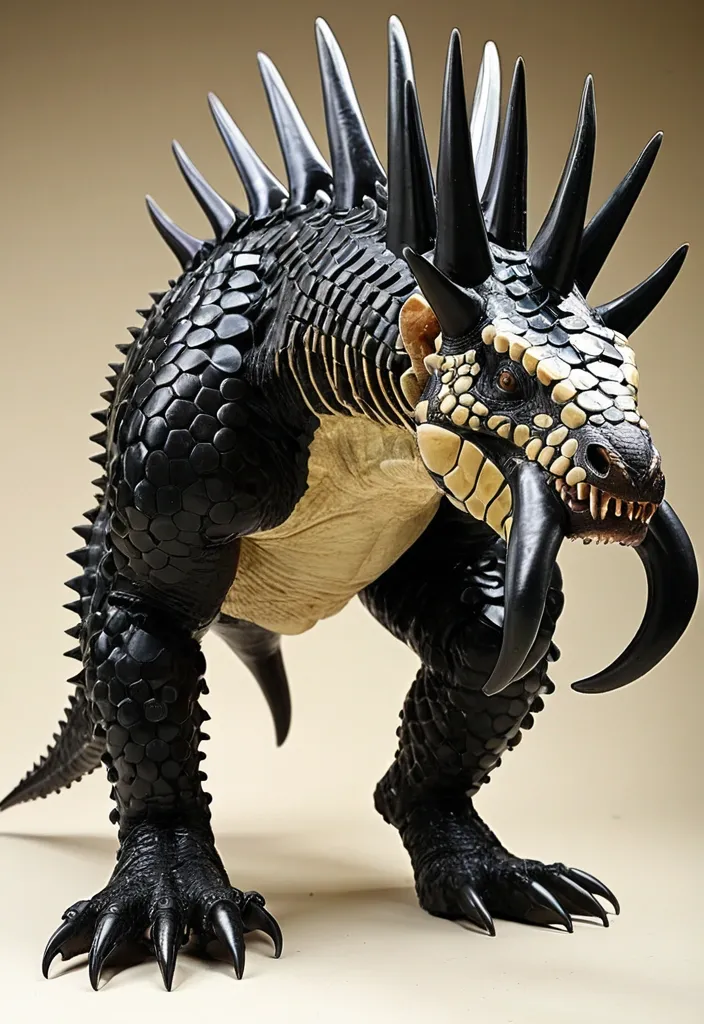
Physical Characteristics: Venenosus Regina is a titanic hybrid dinosaur standing approximately 20 feet tall at the shoulders and stretching 40 feet in length. Its frame is a powerful fusion of Tyrannosaurus rex and Giganotosaurus bulk , with a head shape that blends the robust cranial features of Giganotosaurus and the bony crown of Triceratops. The jawline is adorned with formidable bony spikes on each side , reminiscent of Triceratops horns , enhancing both offense and defense. Its body is armored with large , jet-black , glossy keratin scales inherited from Giant Pangolin DNA , interspersed with cream-colored underbelly patches. These scales are embedded with chromatophore cells from cuttlefish DNA , allowing Venenosus Regina to rapidly alter its skin color , texture , and pattern for camouflage or intimidation. The overall silhouette is muscular , lean and agile , with reduced hind legs that enable knuckle-walking , a trait borrowed from chimpanzee DNA , granting it a unique locomotion style that balances speed and stability.The forelimbs are robust and highly dexterous , equipped with slashing hook claws inspired by Saurophaganax and chimpanzee genetics , capable of delivering devastating swipes and manipulating tools or prey with precision. ,
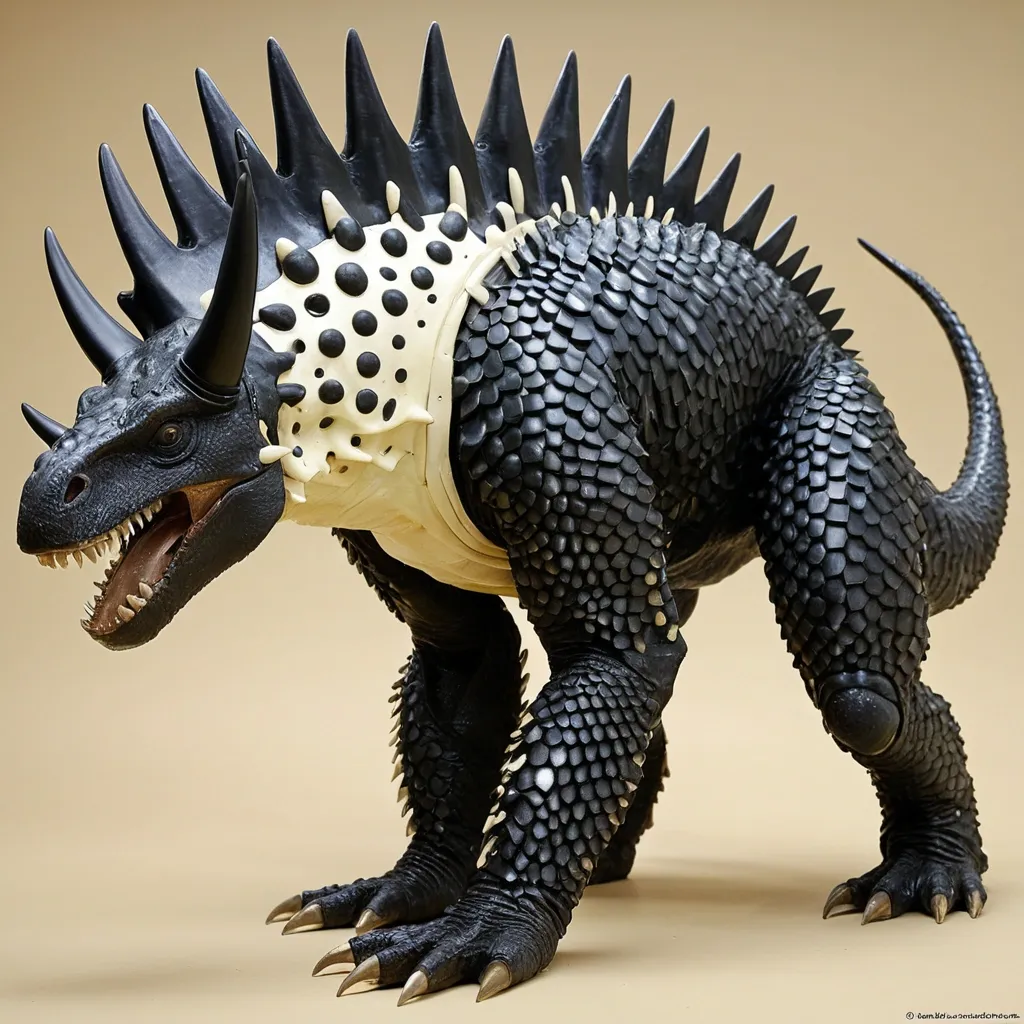
Physical Characteristics: Venenosus Regina is a titanic hybrid dinosaur standing approximately 20 feet tall at the shoulders and stretching 40 feet in length. Its frame is a powerful fusion of Tyrannosaurus rex and Giganotosaurus bulk , with a head shape that blends the robust cranial features of Giganotosaurus and the bony crown of Triceratops. The jawline is adorned with formidable bony spikes on each side , reminiscent of Triceratops horns , enhancing both offense and defense. Its body is armored with large , jet-black , glossy keratin scales inherited from Giant Pangolin DNA , interspersed with cream-colored underbelly patches. These scales are embedded with chromatophore cells from cuttlefish DNA , allowing Venenosus Regina to rapidly alter its skin color , texture , and pattern for camouflage or intimidation. The overall silhouette is muscular , lean and agile , with reduced hind legs that enable knuckle-walking , a trait borrowed from chimpanzee DNA , granting it a unique locomotion style that balances speed and stability.The forelimbs are robust and highly dexterous , equipped with slashing hook claws inspired by Saurophaganax and chimpanzee genetics , capable of delivering devastating swipes and manipulating tools or prey with precision. ,
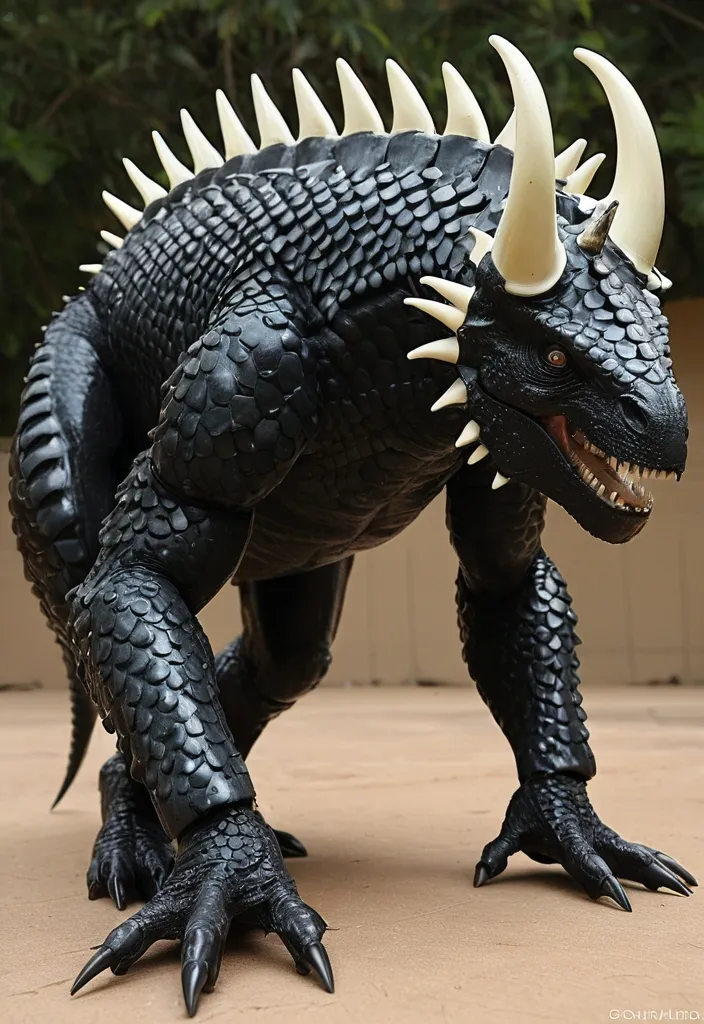
Physical Characteristics: Venenosus Regina is a titanic hybrid dinosaur standing approximately 20 feet tall at the shoulders and stretching 40 feet in length. Its frame is a powerful fusion of Tyrannosaurus rex and Giganotosaurus bulk , with a head shape that blends the robust cranial features of Giganotosaurus and the bony crown of Triceratops. The jawline is adorned with formidable bony spikes on each side , reminiscent of Triceratops horns , enhancing both offense and defense. Its body is armored with large , jet-black , glossy keratin scales inherited from Giant Pangolin DNA , interspersed with cream-colored underbelly patches. These scales are embedded with chromatophore cells from cuttlefish DNA , allowing Venenosus Regina to rapidly alter its skin color , texture , and pattern for camouflage or intimidation. The overall silhouette is muscular , lean and agile , with reduced hind legs that enable knuckle-walking , a trait borrowed from chimpanzee DNA , granting it a unique locomotion style that balances speed and stability.The forelimbs are robust and highly dexterous , equipped with slashing hook claws inspired by Saurophaganax and chimpanzee genetics , capable of delivering devastating swipes and manipulating tools or prey with precision. ,
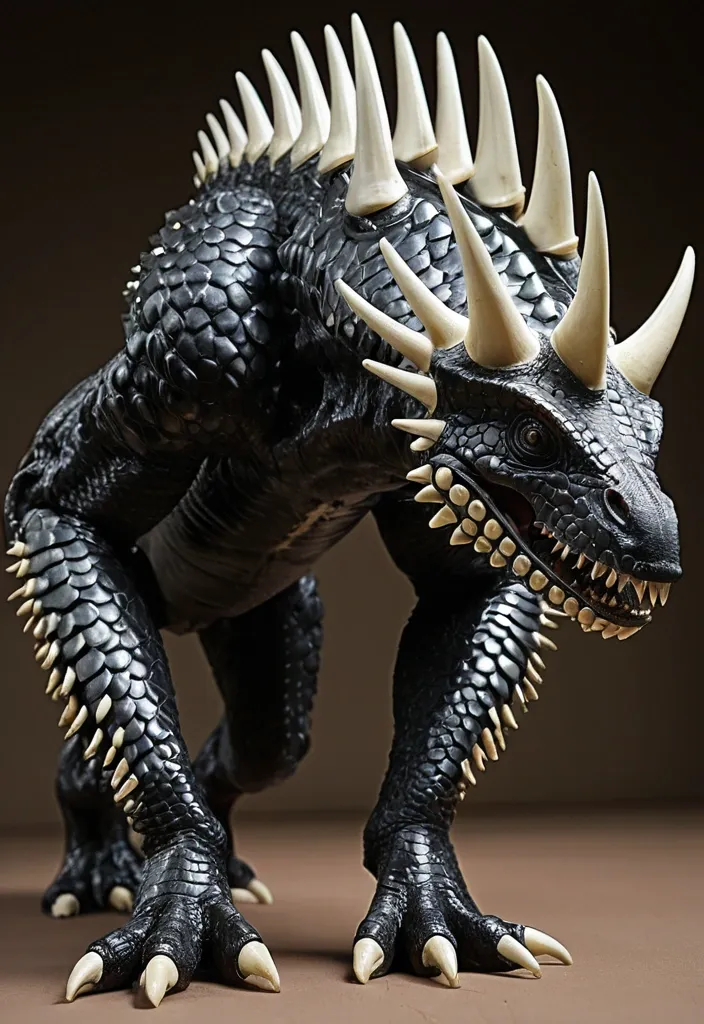
Physical Characteristics: Venenosus Regina is a titanic hybrid dinosaur standing approximately 20 feet tall at the shoulders and stretching 40 feet in length. Its frame is a powerful fusion of Tyrannosaurus rex and Giganotosaurus bulk , with a head shape that blends the robust cranial features of Giganotosaurus and the bony crown of Triceratops. The jawline is adorned with formidable bony spikes on each side , reminiscent of Triceratops horns , enhancing both offense and defense. Its body is armored with large , jet-black , glossy keratin scales inherited from Giant Pangolin DNA , interspersed with cream-colored underbelly patches. These scales are embedded with chromatophore cells from cuttlefish DNA , allowing Venenosus Regina to rapidly alter its skin color , texture , and pattern for camouflage or intimidation. The overall silhouette is muscular , lean and agile , with reduced hind legs that enable knuckle-walking , a trait borrowed from chimpanzee DNA , granting it a unique locomotion style that balances speed and stability.The forelimbs are robust and highly dexterous , equipped with slashing hook claws inspired by Saurophaganax and chimpanzee genetics , capable of delivering devastating swipes and manipulating tools or prey with precision. ,

Physical Characteristics: Venenosus Regina is a titanic hybrid dinosaur standing approximately 20 feet tall at the shoulders and stretching 40 feet in length. Its frame is a powerful fusion of Tyrannosaurus rex and Giganotosaurus bulk , with a head shape that blends the robust cranial features of Giganotosaurus and the bony crown of Triceratops. The jawline is adorned with formidable bony spikes on each side , reminiscent of Triceratops horns , enhancing both offense and defense. Its body is armored with large , jet-black , glossy keratin scales inherited from Giant Pangolin DNA , interspersed with cream-colored underbelly patches. These scales are embedded with chromatophore cells from cuttlefish DNA , allowing Venenosus Regina to rapidly alter its skin color , texture , and pattern for camouflage or intimidation. The overall silhouette is muscular , lean and agile , with reduced hind legs that enable knuckle-walking , a trait borrowed from chimpanzee DNA , granting it a unique locomotion style that balances speed and stability.The forelimbs are robust and highly dexterous , equipped with slashing hook claws inspired by Saurophaganax and chimpanzee genetics , capable of delivering devastating swipes and manipulating tools or prey with precision. ,
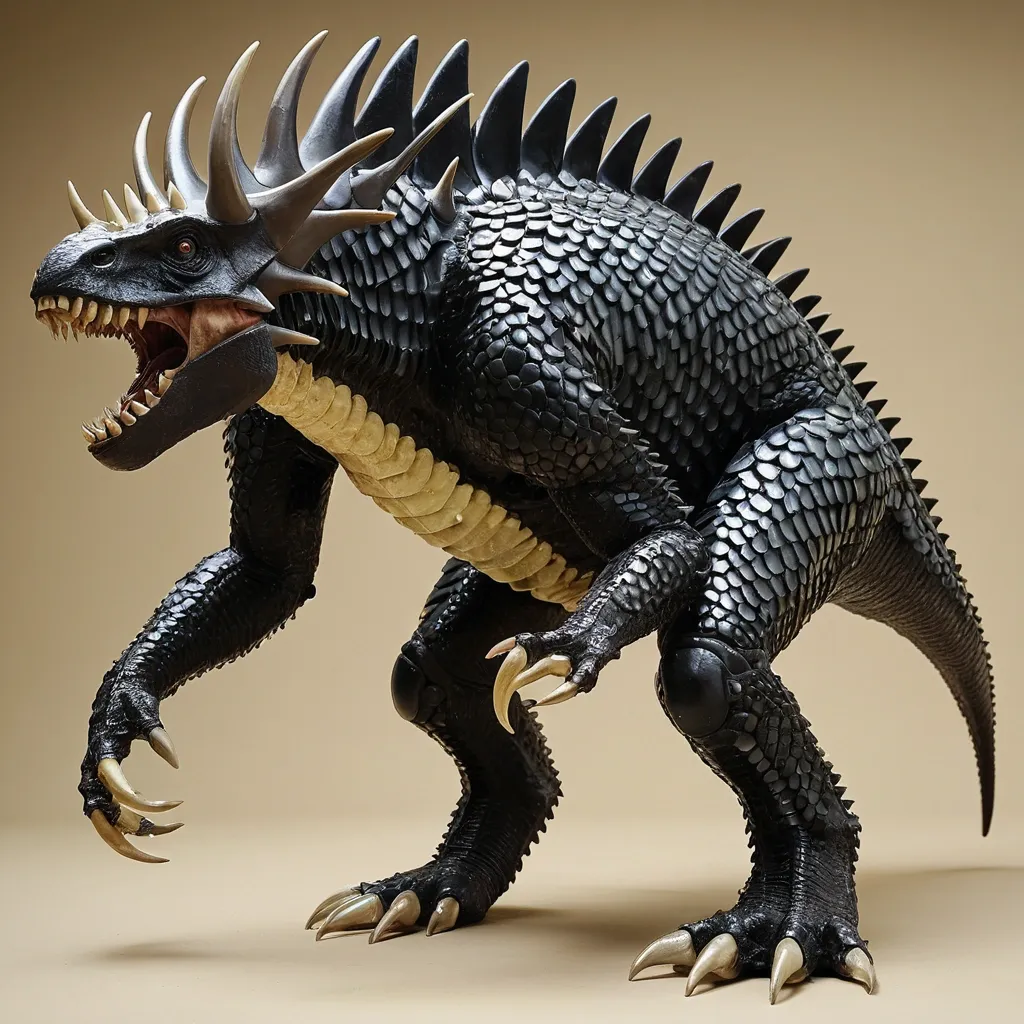
Physical Characteristics: Venenosus Regina is a titanic hybrid dinosaur standing approximately 20 feet tall at the shoulders and stretching 40 feet in length. Its frame is a powerful fusion of Tyrannosaurus rex and Giganotosaurus bulk , with a head shape that blends the robust cranial features of Giganotosaurus and the bony crown of Triceratops. The jawline is adorned with formidable bony spikes on each side , reminiscent of Triceratops horns , enhancing both offense and defense. Its body is armored with large , jet-black , glossy keratin scales inherited from Giant Pangolin DNA , interspersed with cream-colored underbelly patches. These scales are embedded with chromatophore cells from cuttlefish DNA , allowing Venenosus Regina to rapidly alter its skin color , texture , and pattern for camouflage or intimidation. The overall silhouette is muscular , lean and agile , with reduced hind legs that enable knuckle-walking , a trait borrowed from chimpanzee DNA , granting it a unique locomotion style that balances speed and stability.The forelimbs are robust and highly dexterous , equipped with slashing hook claws inspired by Saurophaganax and chimpanzee genetics , capable of delivering devastating swipes and manipulating tools or prey with precision. ,
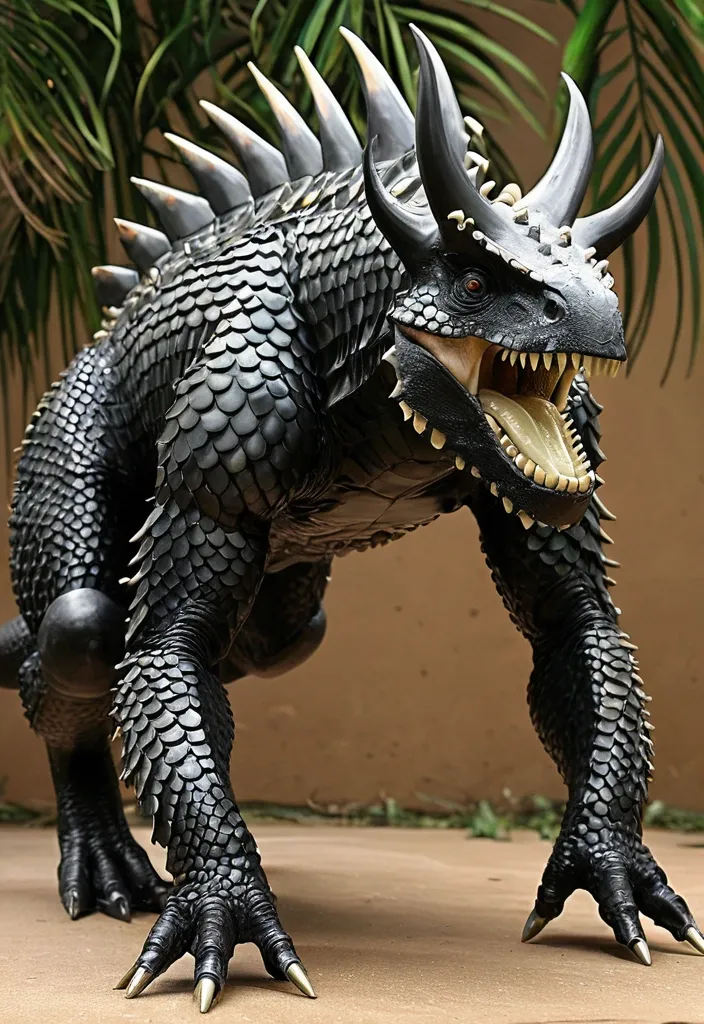
Physical Characteristics: Venenosus Regina is a titanic hybrid dinosaur standing approximately 20 feet tall at the shoulders and stretching 40 feet in length. Its frame is a powerful fusion of Tyrannosaurus rex and Giganotosaurus bulk , with a head shape that blends the robust cranial features of Giganotosaurus and the bony crown of Triceratops. The jawline is adorned with formidable bony spikes on each side , reminiscent of Triceratops horns , enhancing both offense and defense. Its body is armored with large , jet-black , glossy keratin scales inherited from Giant Pangolin DNA , interspersed with cream-colored underbelly patches. These scales are embedded with chromatophore cells from cuttlefish DNA , allowing Venenosus Regina to rapidly alter its skin color , texture , and pattern for camouflage or intimidation. The overall silhouette is muscular , lean and agile , with reduced hind legs that enable knuckle-walking , a trait borrowed from chimpanzee DNA , granting it a unique locomotion style that balances speed and stability.The forelimbs are robust and highly dexterous , equipped with slashing hook claws inspired by Saurophaganax and chimpanzee genetics , capable of delivering devastating swipes and manipulating tools or prey with precision. ,
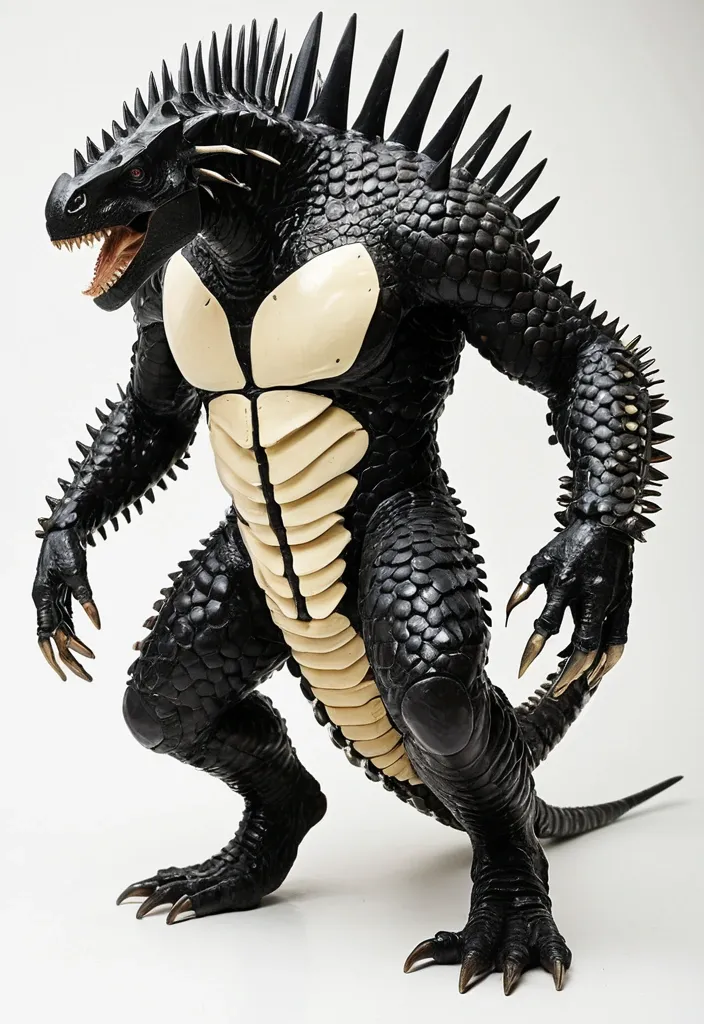
Physical Characteristics: Venenosus Regina is a titanic hybrid dinosaur standing approximately 20 feet tall at the shoulders and stretching 40 feet in length. Its frame is a powerful fusion of Tyrannosaurus rex and Giganotosaurus bulk , with a head shape that blends the robust cranial features of Giganotosaurus and the bony crown of Triceratops. The jawline is adorned with formidable bony spikes on each side , reminiscent of Triceratops horns , enhancing both offense and defense. Its body is armored with large , jet-black , glossy keratin scales inherited from Giant Pangolin DNA , interspersed with cream-colored underbelly patches. These scales are embedded with chromatophore cells from cuttlefish DNA , allowing Venenosus Regina to rapidly alter its skin color , texture , and pattern for camouflage or intimidation. The overall silhouette is muscular , lean and agile , with reduced hind legs that enable knuckle-walking , a trait borrowed from chimpanzee DNA , granting it a unique locomotion style that balances speed and stability.The forelimbs are robust and highly dexterous , equipped with slashing hook claws inspired by Saurophaganax and chimpanzee genetics , capable of delivering devastating swipes and manipulating tools or prey with precision. ,
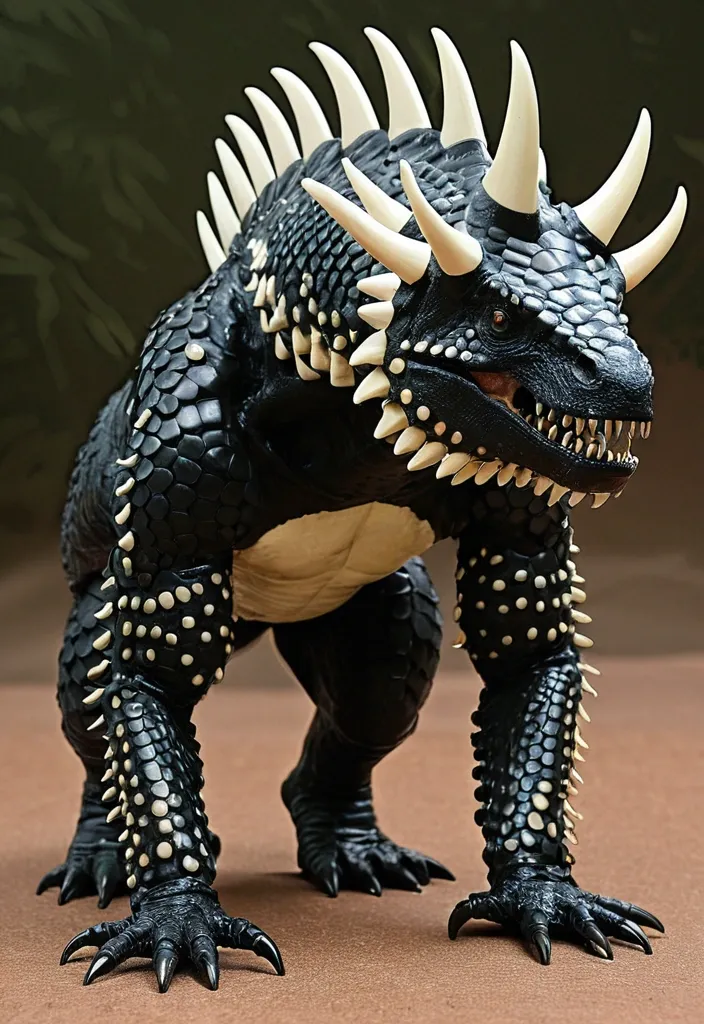
Physical Characteristics: Venenosus Regina is a titanic hybrid dinosaur standing approximately 20 feet tall at the shoulders and stretching 40 feet in length. Its frame is a powerful fusion of Tyrannosaurus rex and Giganotosaurus bulk , with a head shape that blends the robust cranial features of Giganotosaurus and the bony crown of Triceratops. The jawline is adorned with formidable bony spikes on each side , reminiscent of Triceratops horns , enhancing both offense and defense. Its body is armored with large , jet-black , glossy keratin scales inherited from Giant Pangolin DNA , interspersed with cream-colored underbelly patches. These scales are embedded with chromatophore cells from cuttlefish DNA , allowing Venenosus Regina to rapidly alter its skin color , texture , and pattern for camouflage or intimidation. The overall silhouette is muscular , lean and agile , with reduced hind legs that enable knuckle-walking , a trait borrowed from chimpanzee DNA , granting it a unique locomotion style that balances speed and stability.The forelimbs are robust and highly dexterous , equipped with slashing hook claws inspired by Saurophaganax and chimpanzee genetics , capable of delivering devastating swipes and manipulating tools or prey with precision. ,
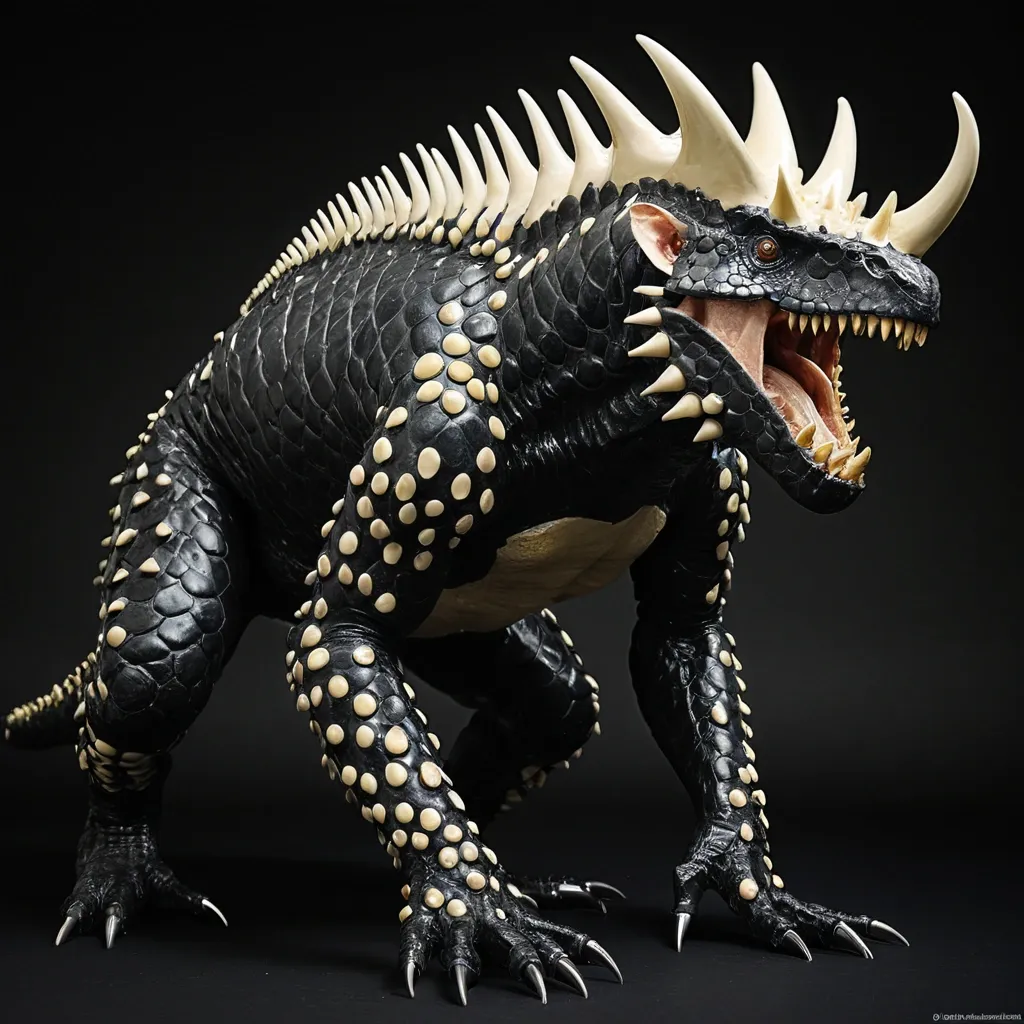
Physical Characteristics: Venenosus Regina is a titanic hybrid dinosaur standing approximately 20 feet tall at the shoulders and stretching 40 feet in length. Its frame is a powerful fusion of Tyrannosaurus rex and Giganotosaurus bulk , with a head shape that blends the robust cranial features of Giganotosaurus and the bony crown of Triceratops. The jawline is adorned with formidable bony spikes on each side , reminiscent of Triceratops horns , enhancing both offense and defense. Its body is armored with large , jet-black , glossy keratin scales inherited from Giant Pangolin DNA , interspersed with cream-colored underbelly patches. These scales are embedded with chromatophore cells from cuttlefish DNA , allowing Venenosus Regina to rapidly alter its skin color , texture , and pattern for camouflage or intimidation. The overall silhouette is muscular , lean and agile , with reduced hind legs that enable knuckle-walking , a trait borrowed from chimpanzee DNA , granting it a unique locomotion style that balances speed and stability.The forelimbs are robust and highly dexterous , equipped with slashing hook claws inspired by Saurophaganax and chimpanzee genetics , capable of delivering devastating swipes and manipulating tools or prey with precision. ,

Physical Characteristics: Venenosus Regina is a titanic hybrid dinosaur standing approximately 20 feet tall at the shoulders and stretching 40 feet in length. Its frame is a powerful fusion of Tyrannosaurus rex and Giganotosaurus bulk , with a head shape that blends the robust cranial features of Giganotosaurus and the bony crown of Triceratops. The jawline is adorned with formidable bony spikes on each side , reminiscent of Triceratops horns , enhancing both offense and defense. Its body is armored with large , jet-black , glossy keratin scales inherited from Giant Pangolin DNA , interspersed with cream-colored underbelly patches. These scales are embedded with chromatophore cells from cuttlefish DNA , allowing Venenosus Regina to rapidly alter its skin color , texture , and pattern for camouflage or intimidation. The overall silhouette is muscular , lean and agile , with reduced hind legs that enable knuckle-walking , a trait borrowed from chimpanzee DNA , granting it a unique locomotion style that balances speed and stability.The forelimbs are robust and highly dexterous , equipped with slashing hook claws inspired by Saurophaganax and chimpanzee genetics , capable of delivering devastating swipes and manipulating tools or prey with precision. ,
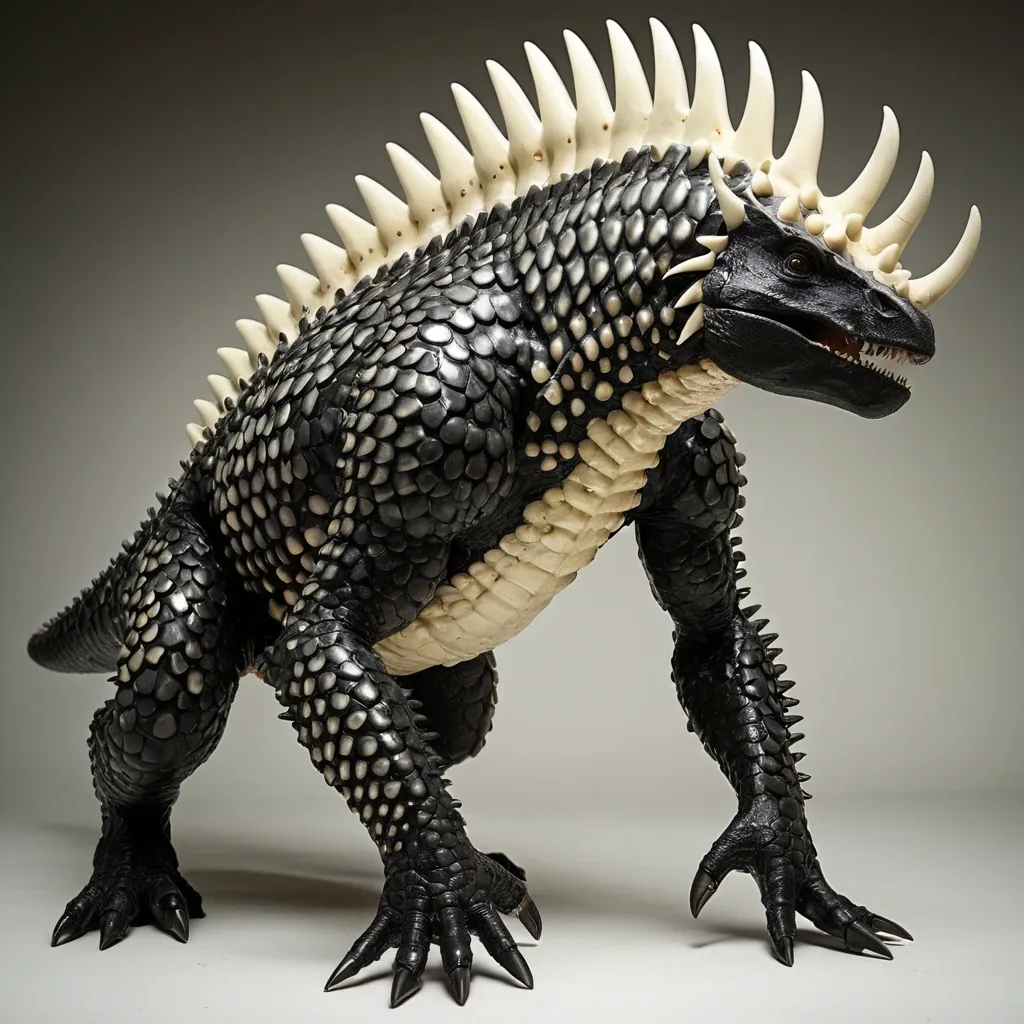
Physical Characteristics: Venenosus Regina is a titanic hybrid dinosaur standing approximately 20 feet tall at the shoulders and stretching 40 feet in length. Its frame is a powerful fusion of Tyrannosaurus rex and Giganotosaurus bulk , with a head shape that blends the robust cranial features of Giganotosaurus and the bony crown of Triceratops. The jawline is adorned with formidable bony spikes on each side , reminiscent of Triceratops horns , enhancing both offense and defense. Its body is armored with large , jet-black , glossy keratin scales inherited from Giant Pangolin DNA , interspersed with cream-colored underbelly patches. These scales are embedded with chromatophore cells from cuttlefish DNA , allowing Venenosus Regina to rapidly alter its skin color , texture , and pattern for camouflage or intimidation. The overall silhouette is muscular , lean and agile , with reduced hind legs that enable knuckle-walking , a trait borrowed from chimpanzee DNA , granting it a unique locomotion style that balances speed and stability.The forelimbs are robust and highly dexterous , equipped with slashing hook claws inspired by Saurophaganax and chimpanzee genetics , capable of delivering devastating swipes and manipulating tools or prey with precision. ,
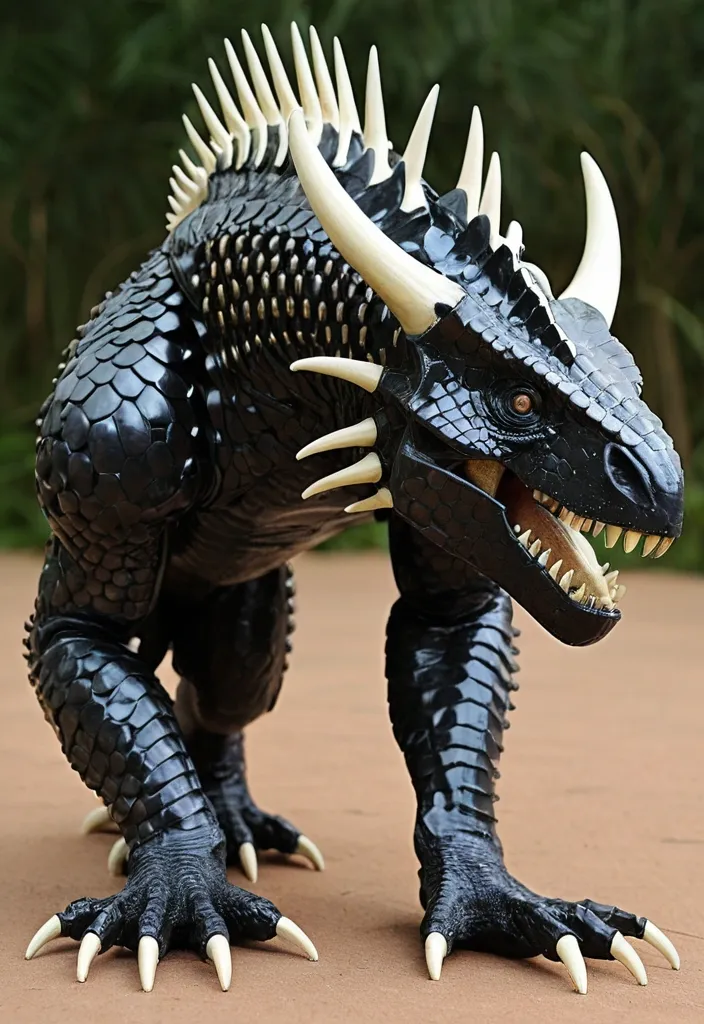
Physical Characteristics:Venenosus Regina is a titanic hybrid dinosaur standing approximately 20 feet tall at the shoulders and stretching 40 feet in length. Its frame is a powerful fusion of Tyrannosaurus rex and Giganotosaurus bulk , with a head shape that blends the robust cranial features of Giganotosaurus and the bony crown of Triceratops. The jawline is adorned with formidable bony spikes on each side , reminiscent of Triceratops horns , enhancing both offense and defense.Its body is armored with large , jet-black , glossy keratin scales inherited from Giant Pangolin DNA , interspersed with cream-colored underbelly patches. These scales are embedded with chromatophore cells from cuttlefish DNA , allowing Venenosus Regina to rapidly alter its skin color , texture , and pattern for camouflage or intimidation. The overall silhouette is muscular and agile , with reduced hind legs that enable knuckle-walking , a trait borrowed from chimpanzee DNA , granting it a unique locomotion style that balances speed and stability.The forelimbs are robust and highly dexterous , equipped with slashing hook claws inspired by Saurophaganax and chimpanzee genetics , capable of delivering devastating swipes and manipulating tools or prey with precision. ,
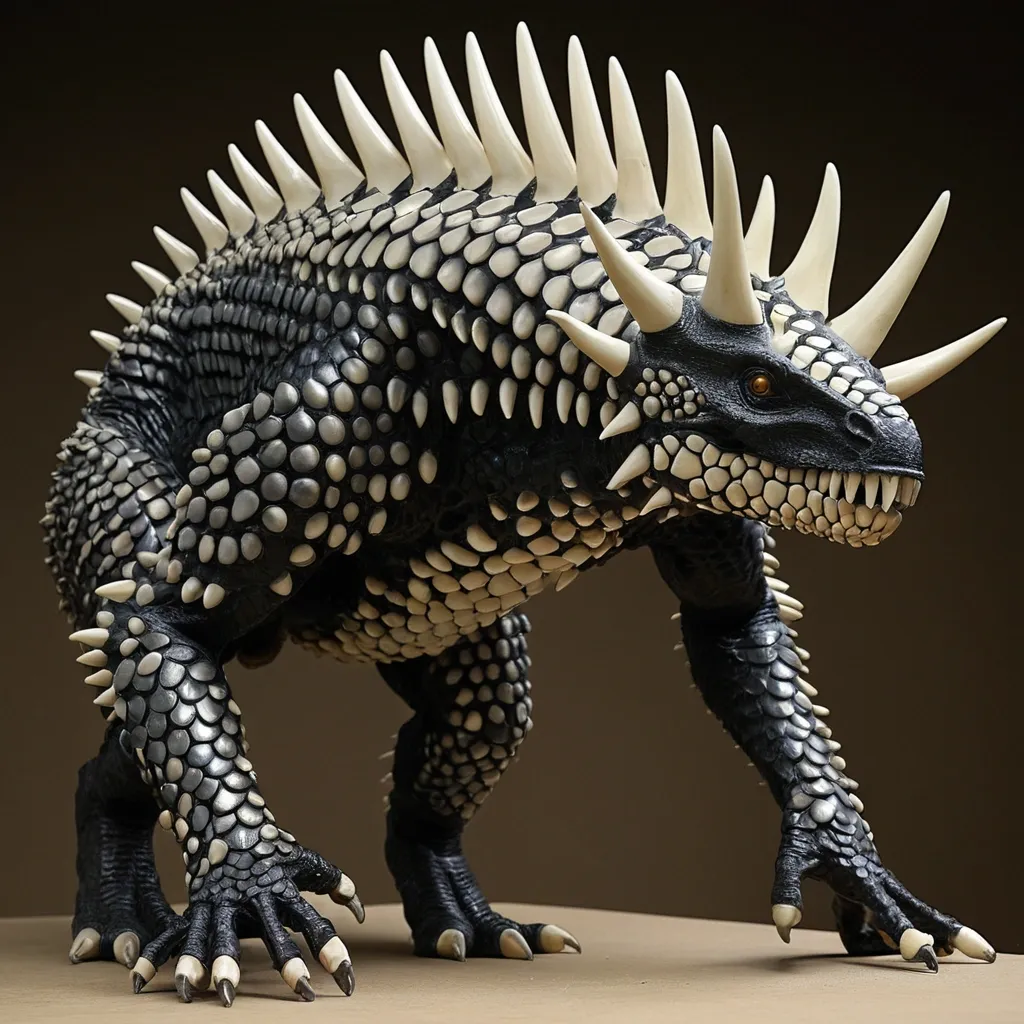
Physical Characteristics:Venenosus Regina is a titanic hybrid dinosaur standing approximately 20 feet tall at the shoulders and stretching 40 feet in length. Its frame is a powerful fusion of Tyrannosaurus rex and Giganotosaurus bulk , with a head shape that blends the robust cranial features of Giganotosaurus and the bony crown of Triceratops. The jawline is adorned with formidable bony spikes on each side , reminiscent of Triceratops horns , enhancing both offense and defense.Its body is armored with large , jet-black , glossy keratin scales inherited from Giant Pangolin DNA , interspersed with cream-colored underbelly patches. These scales are embedded with chromatophore cells from cuttlefish DNA , allowing Venenosus Regina to rapidly alter its skin color , texture , and pattern for camouflage or intimidation. The overall silhouette is muscular and agile , with reduced hind legs that enable knuckle-walking , a trait borrowed from chimpanzee DNA , granting it a unique locomotion style that balances speed and stability.The forelimbs are robust and highly dexterous , equipped with slashing hook claws inspired by Saurophaganax and chimpanzee genetics , capable of delivering devastating swipes and manipulating tools or prey with precision. ,
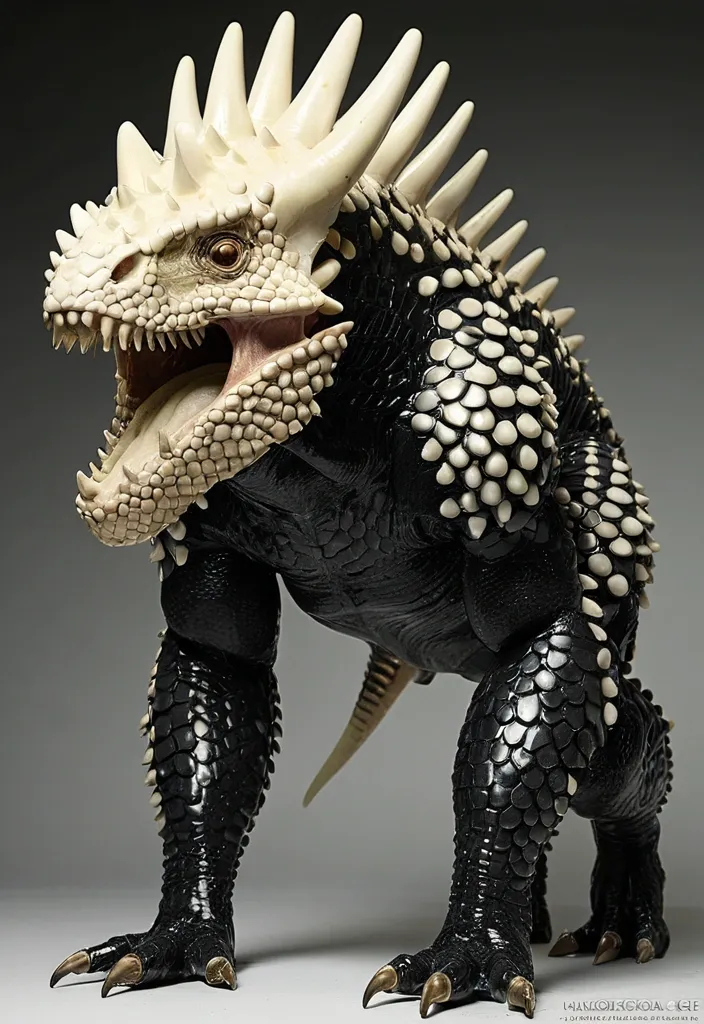
Physical Characteristics:Venenosus Regina is a titanic hybrid dinosaur standing approximately 20 feet tall at the shoulders and stretching 40 feet in length. Its frame is a powerful fusion of Tyrannosaurus rex and Giganotosaurus bulk , with a head shape that blends the robust cranial features of Giganotosaurus and the bony crown of Triceratops. The jawline is adorned with formidable bony spikes on each side , reminiscent of Triceratops horns , enhancing both offense and defense.Its body is armored with large , jet-black , glossy keratin scales inherited from Giant Pangolin DNA , interspersed with cream-colored underbelly patches. These scales are embedded with chromatophore cells from cuttlefish DNA , allowing Venenosus Regina to rapidly alter its skin color , texture , and pattern for camouflage or intimidation. The overall silhouette is muscular and agile , with reduced hind legs that enable knuckle-walking , a trait borrowed from chimpanzee DNA , granting it a unique locomotion style that balances speed and stability.The forelimbs are robust and highly dexterous , equipped with slashing hook claws inspired by Saurophaganax and chimpanzee genetics , capable of delivering devastating swipes and manipulating tools or prey with precision. ,
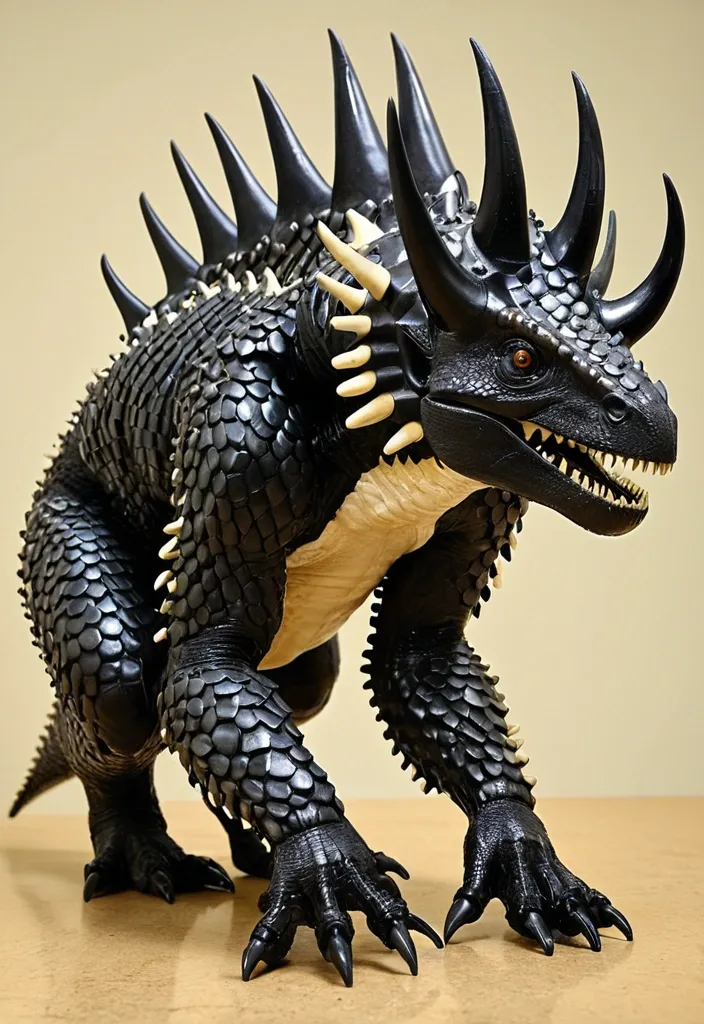
Physical Characteristics:Venenosus Regina is a titanic hybrid dinosaur standing approximately 20 feet tall at the shoulders and stretching 40 feet in length. Its frame is a powerful fusion of Tyrannosaurus rex and Giganotosaurus bulk , with a head shape that blends the robust cranial features of Giganotosaurus and the bony crown of Triceratops. The jawline is adorned with formidable bony spikes on each side , reminiscent of Triceratops horns , enhancing both offense and defense.Its body is armored with large , jet-black , glossy keratin scales inherited from Giant Pangolin DNA , interspersed with cream-colored underbelly patches. These scales are embedded with chromatophore cells from cuttlefish DNA , allowing Venenosus Regina to rapidly alter its skin color , texture , and pattern for camouflage or intimidation. The overall silhouette is muscular and agile , with reduced hind legs that enable knuckle-walking , a trait borrowed from chimpanzee DNA , granting it a unique locomotion style that balances speed and stability.The forelimbs are robust and highly dexterous , equipped with slashing hook claws inspired by Saurophaganax and chimpanzee genetics , capable of delivering devastating swipes and manipulating tools or prey with precision. ,
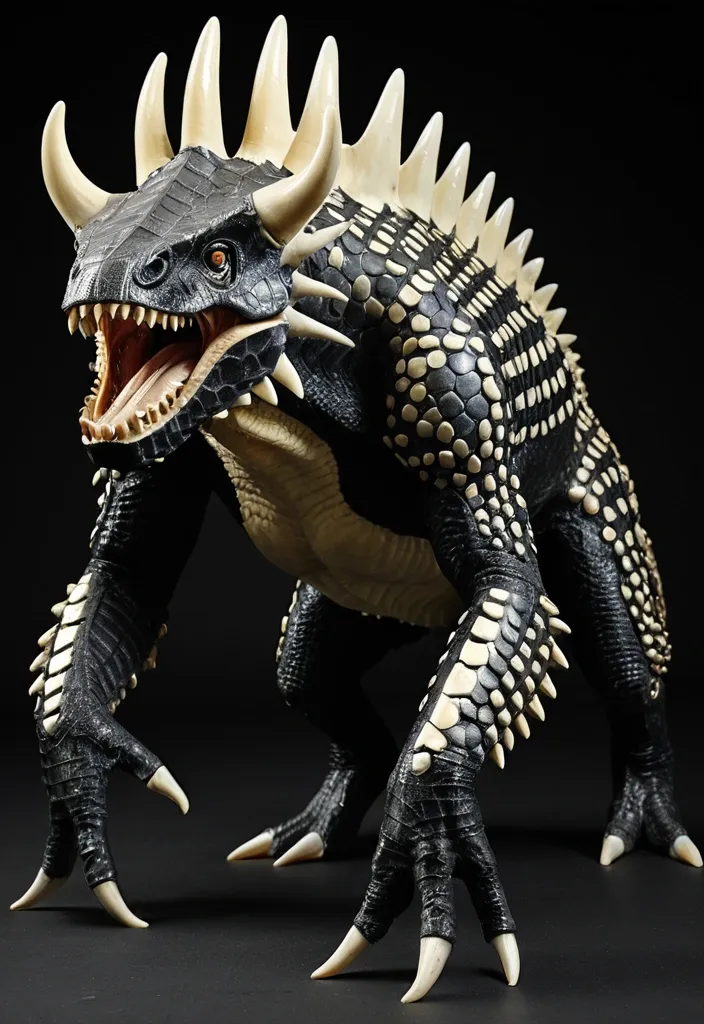
Physical Characteristics:Venenosus Regina is a titanic hybrid dinosaur standing approximately 20 feet tall at the shoulders and stretching 40 feet in length. Its frame is a powerful fusion of Tyrannosaurus rex and Giganotosaurus bulk , with a head shape that blends the robust cranial features of Giganotosaurus and the bony crown of Triceratops. The jawline is adorned with formidable bony spikes on each side , reminiscent of Triceratops horns , enhancing both offense and defense.Its body is armored with large , jet-black , glossy keratin scales inherited from Giant Pangolin DNA , interspersed with cream-colored underbelly patches. These scales are embedded with chromatophore cells from cuttlefish DNA , allowing Venenosus Regina to rapidly alter its skin color , texture , and pattern for camouflage or intimidation. The overall silhouette is muscular and agile , with reduced hind legs that enable knuckle-walking , a trait borrowed from chimpanzee DNA , granting it a unique locomotion style that balances speed and stability.The forelimbs are robust and highly dexterous , equipped with slashing hook claws inspired by Saurophaganax and chimpanzee genetics , capable of delivering devastating swipes and manipulating tools or prey with precision. ,
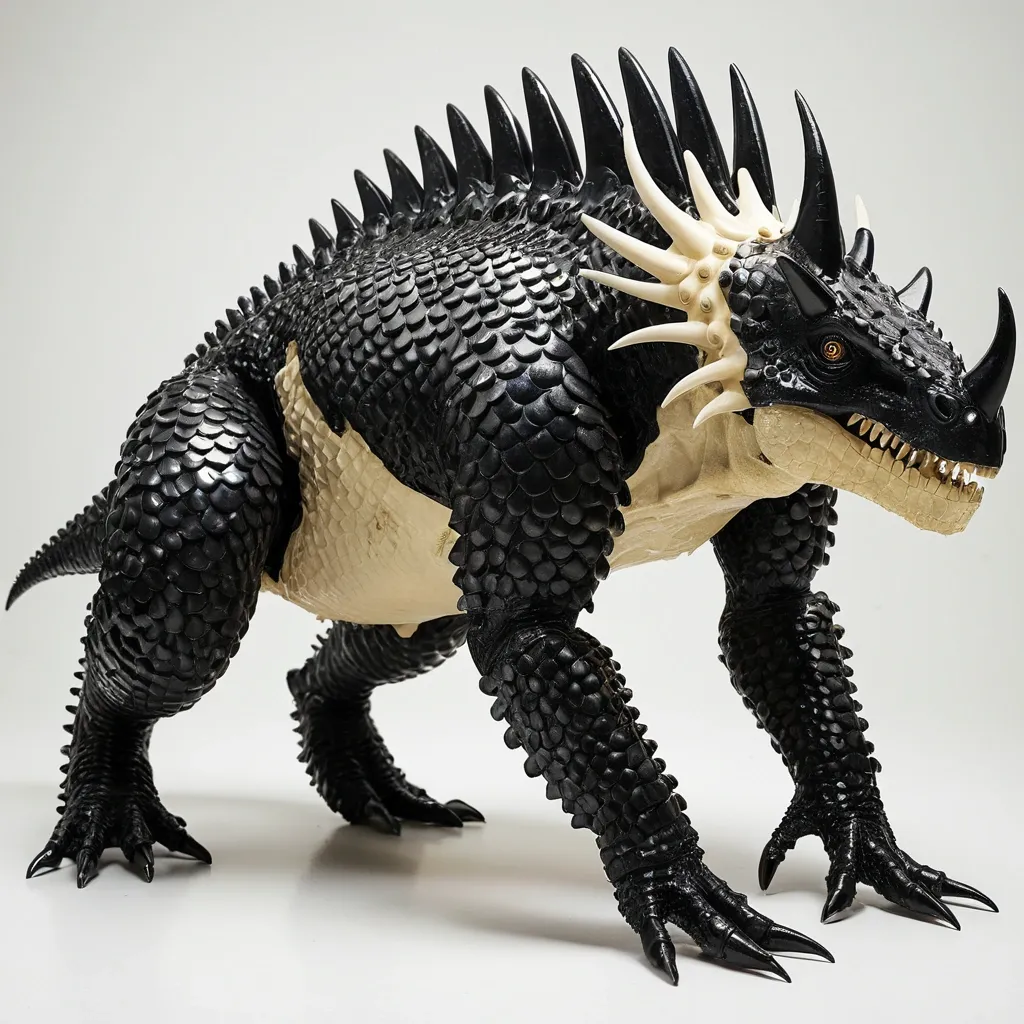
Physical Characteristics:Venenosus Regina is a titanic hybrid dinosaur standing approximately 20 feet tall at the shoulders and stretching 40 feet in length. Its frame is a powerful fusion of Tyrannosaurus rex and Giganotosaurus bulk , with a head shape that blends the robust cranial features of Giganotosaurus and the bony crown of Triceratops. The jawline is adorned with formidable bony spikes on each side , reminiscent of Triceratops horns , enhancing both offense and defense.Its body is armored with large , jet-black , glossy keratin scales inherited from Giant Pangolin DNA , interspersed with cream-colored underbelly patches. These scales are embedded with chromatophore cells from cuttlefish DNA , allowing Venenosus Regina to rapidly alter its skin color , texture , and pattern for camouflage or intimidation. The overall silhouette is muscular and agile , with reduced hind legs that enable knuckle-walking , a trait borrowed from chimpanzee DNA , granting it a unique locomotion style that balances speed and stability.The forelimbs are robust and highly dexterous , equipped with slashing hook claws inspired by Saurophaganax and chimpanzee genetics , capable of delivering devastating swipes and manipulating tools or prey with precision. ,
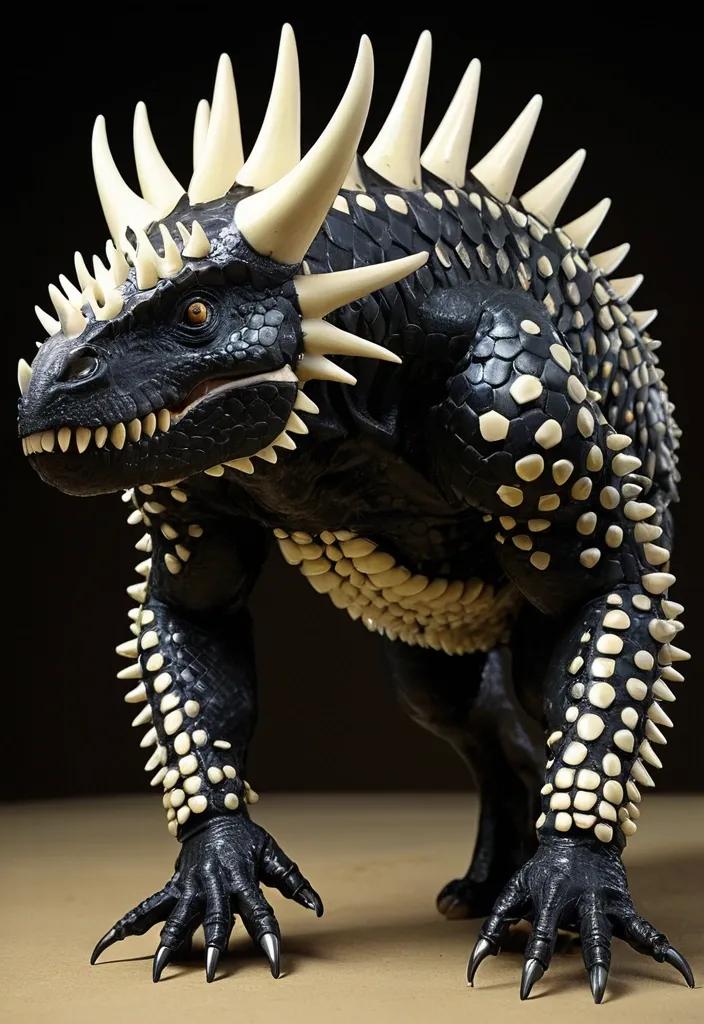
Physical Characteristics: Venenosus Regina is a titanic hybrid dinosaur standing approximately 20 feet tall at the shoulders and stretching 40 feet in length. Its frame is a powerful fusion of Tyrannosaurus rex and Giganotosaurus bulk , with a head shape that blends the robust cranial features of Giganotosaurus and the bony crown of Triceratops. The jawline is adorned with formidable bony spikes on each side , reminiscent of Triceratops horns , enhancing both offense and defense. Its body is armored with large , jet-black , glossy keratin scales inherited from Giant Pangolin DNA , interspersed with cream-colored underbelly patches. These scales are embedded with chromatophore cells from cuttlefish DNA , allowing Venenosus Regina to rapidly alter its skin color , texture , and pattern for camouflage or intimidation. The overall silhouette is muscular and agile , with reduced hind legs that enable knuckle-walking , a trait borrowed from chimpanzee DNA , granting it a unique locomotion style that balances speed and stability. The forelimbs are robust and highly dexterous , equipped with slashing hook claws inspired by Saurophaganax and chimpanzee genetics , capable of delivering devastating swipes and manipulating tools or prey with precision. ,
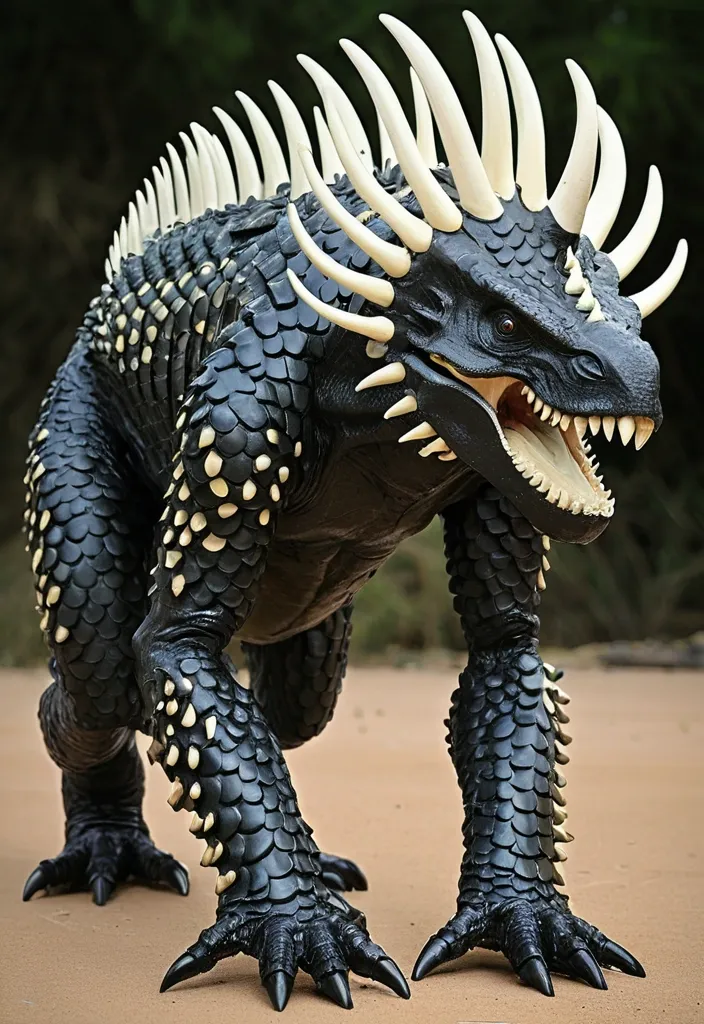
Physical Characteristics: Venenosus Regina is a titanic hybrid dinosaur standing approximately 20 feet tall at the shoulders and stretching 40 feet in length. Its frame is a powerful fusion of Tyrannosaurus rex and Giganotosaurus bulk , with a head shape that blends the robust cranial features of Giganotosaurus and the bony crown of Triceratops. The jawline is adorned with formidable bony spikes on each side , reminiscent of Triceratops horns , enhancing both offense and defense. Its body is armored with large , jet-black , glossy keratin scales inherited from Giant Pangolin DNA , interspersed with cream-colored underbelly patches. These scales are embedded with chromatophore cells from cuttlefish DNA , allowing Venenosus Regina to rapidly alter its skin color , texture , and pattern for camouflage or intimidation. The overall silhouette is muscular and agile , with reduced hind legs that enable knuckle-walking , a trait borrowed from chimpanzee DNA , granting it a unique locomotion style that balances speed and stability. The forelimbs are robust and highly dexterous , equipped with slashing hook claws inspired by Saurophaganax and chimpanzee genetics , capable of delivering devastating swipes and manipulating tools or prey with precision. ,
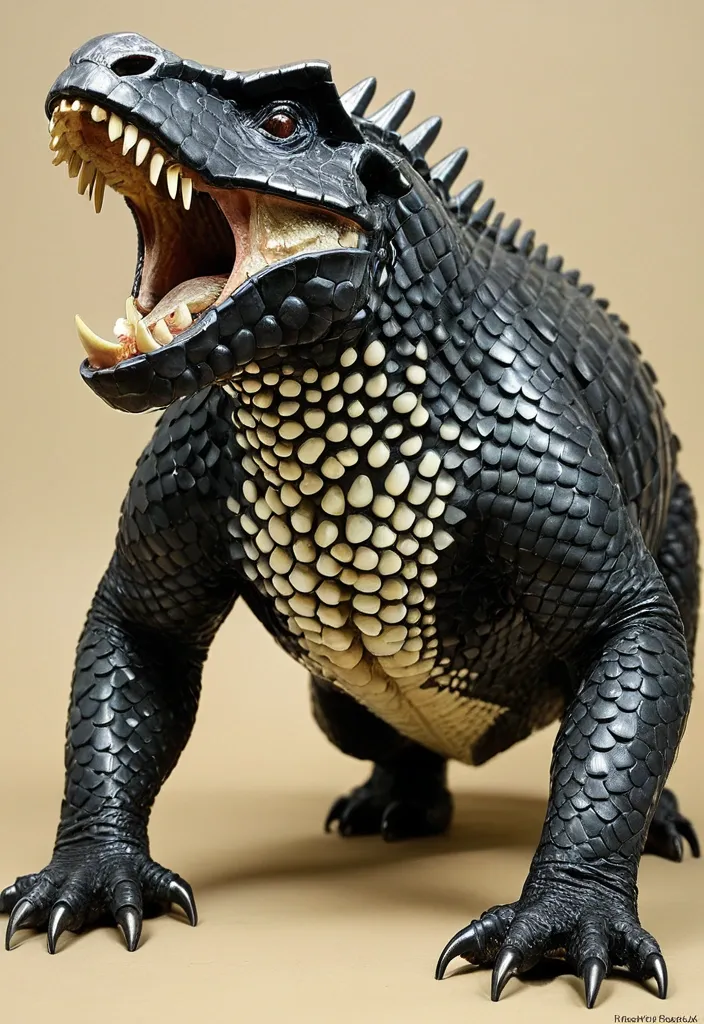
Physical Description Venenosus Rex is a colossal and fearsome hybrid towering 20 feet tall at the shoulders and stretching about 40 feet from snout to tail tip. Its physique combines the massive muscular bulk of Tyrannosaurus rex and Giganotosaurus with the robust cranial features of Triceratops , including a partially horned , powerful head capable of delivering bone-crushing bites. The jaw can unhinge to an incredible 90 degrees , allowing it to swallow large prey whole or deliver devastating bites. Its teeth are a lethal blend of Northern short-tailed shrew iron-hard enamel , Inland Taipan’s retractable fangs , and Komodo Dragon’s serrated edges , designed for penetrating thick armor and flesh alike.The body is covered in large , jet-black , glossy keratinous scales inherited from Giant Pangolin , Triceratops , and Scelidosaurus DNA , forming near-impenetrable natural armor. These scales are interspersed with cream-colored patches along the underbelly , embedded with chromatophore cells from cuttlefish DNA , allowing the hybrid to rapidly change color , texture , and pattern for camouflage or intimidation.Its forelimbs are powerful and dexterous , enhanced by Saurophaganax and chimpanzee DNA , featuring long , slashing hook claws capable of incapacitating larger foes or manipulating tools during hunts. The hind limbs are somewhat reduced and adapted for knuckle-walking , a trait borrowed from chimpanzees , contributing to its unique locomotion style and enhanced stability. ,
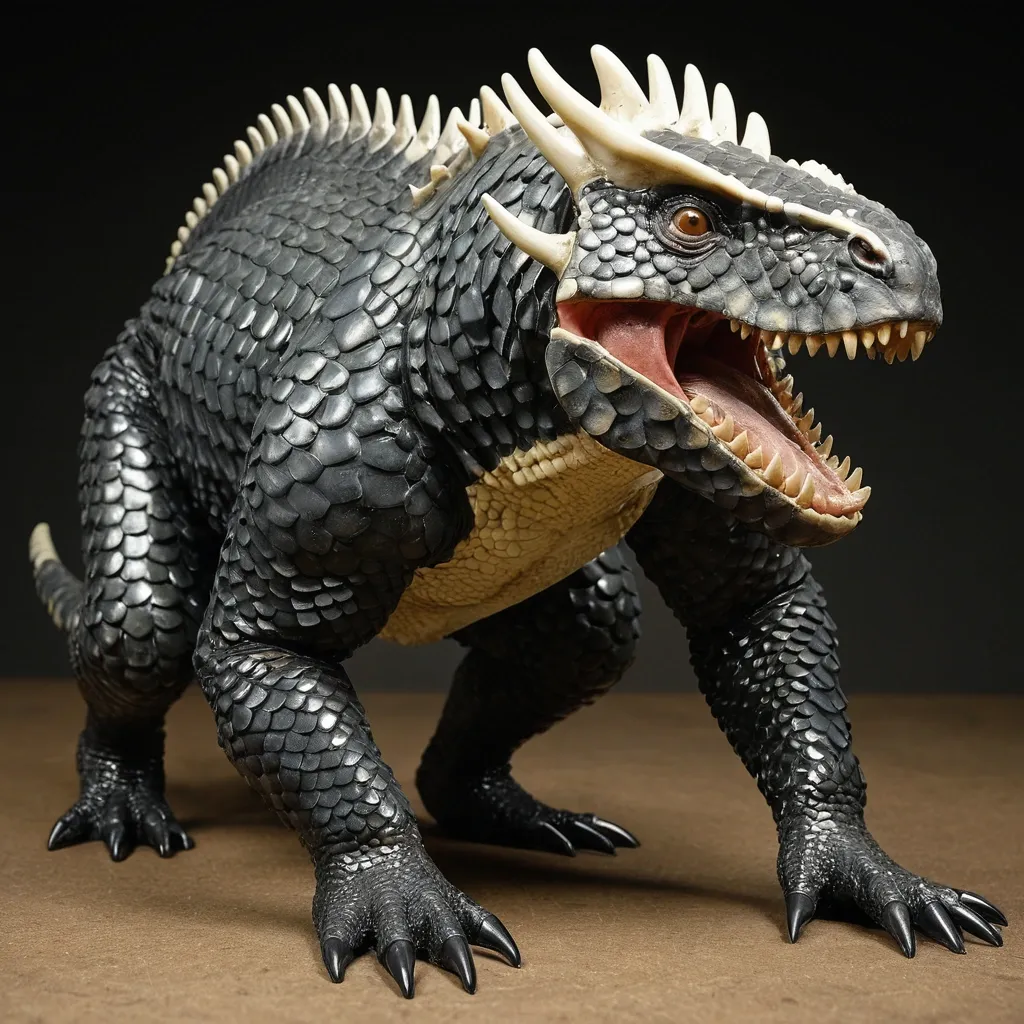
Physical Description Venenosus Rex is a colossal and fearsome hybrid towering 20 feet tall at the shoulders and stretching about 40 feet from snout to tail tip. Its physique combines the massive muscular bulk of Tyrannosaurus rex and Giganotosaurus with the robust cranial features of Triceratops , including a partially horned , powerful head capable of delivering bone-crushing bites. The jaw can unhinge to an incredible 90 degrees , allowing it to swallow large prey whole or deliver devastating bites. Its teeth are a lethal blend of Northern short-tailed shrew iron-hard enamel , Inland Taipan’s retractable fangs , and Komodo Dragon’s serrated edges , designed for penetrating thick armor and flesh alike.The body is covered in large , jet-black , glossy keratinous scales inherited from Giant Pangolin , Triceratops , and Scelidosaurus DNA , forming near-impenetrable natural armor. These scales are interspersed with cream-colored patches along the underbelly , embedded with chromatophore cells from cuttlefish DNA , allowing the hybrid to rapidly change color , texture , and pattern for camouflage or intimidation.Its forelimbs are powerful and dexterous , enhanced by Saurophaganax and chimpanzee DNA , featuring long , slashing hook claws capable of incapacitating larger foes or manipulating tools during hunts. The hind limbs are somewhat reduced and adapted for knuckle-walking , a trait borrowed from chimpanzees , contributing to its unique locomotion style and enhanced stability. ,
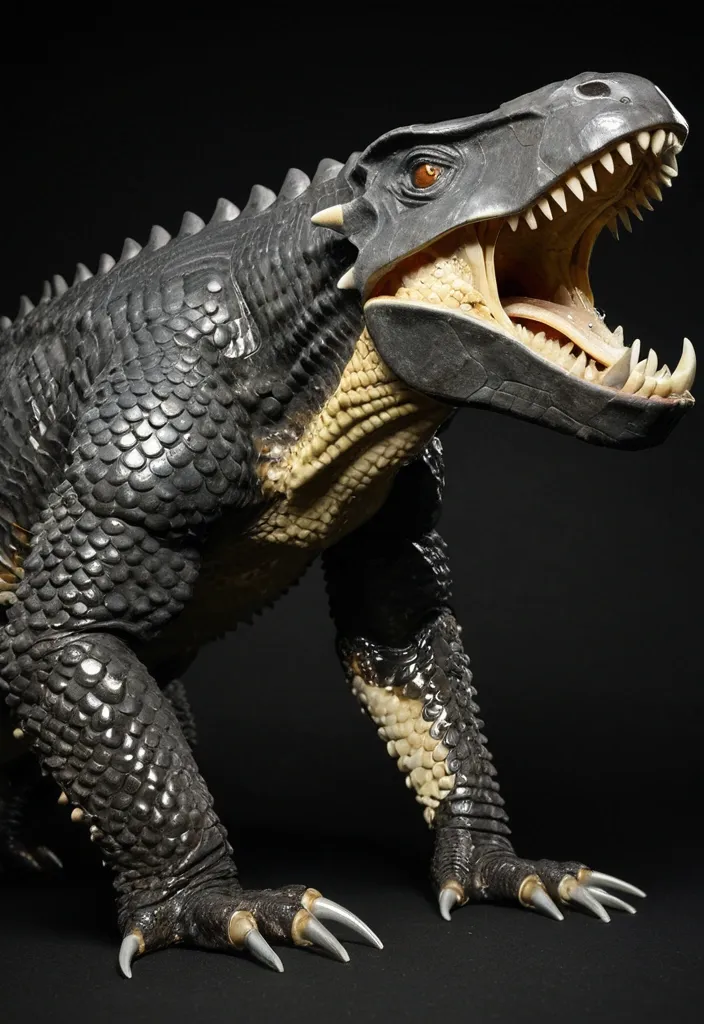
Physical Description Venenosus Rex is a colossal and fearsome hybrid towering 20 feet tall at the shoulders and stretching about 40 feet from snout to tail tip. Its physique combines the massive muscular bulk of Tyrannosaurus rex and Giganotosaurus with the robust cranial features of Triceratops , including a partially horned , powerful head capable of delivering bone-crushing bites. The jaw can unhinge to an incredible 90 degrees , allowing it to swallow large prey whole or deliver devastating bites. Its teeth are a lethal blend of Northern short-tailed shrew iron-hard enamel , Inland Taipan’s retractable fangs , and Komodo Dragon’s serrated edges , designed for penetrating thick armor and flesh alike.The body is covered in large , jet-black , glossy keratinous scales inherited from Giant Pangolin , Triceratops , and Scelidosaurus DNA , forming near-impenetrable natural armor. These scales are interspersed with cream-colored patches along the underbelly , embedded with chromatophore cells from cuttlefish DNA , allowing the hybrid to rapidly change color , texture , and pattern for camouflage or intimidation.Its forelimbs are powerful and dexterous , enhanced by Saurophaganax and chimpanzee DNA , featuring long , slashing hook claws capable of incapacitating larger foes or manipulating tools during hunts. The hind limbs are somewhat reduced and adapted for knuckle-walking , a trait borrowed from chimpanzees , contributing to its unique locomotion style and enhanced stability. ,
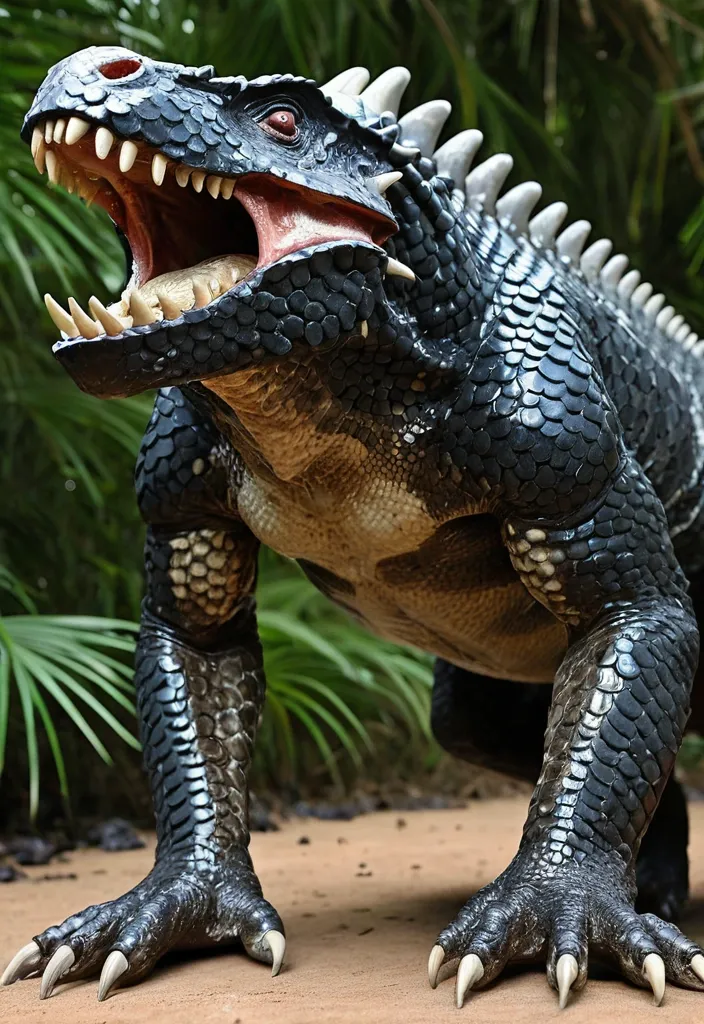
Physical Description Venenosus Rex is a colossal and fearsome hybrid towering 20 feet tall at the shoulders and stretching about 40 feet from snout to tail tip. Its physique combines the massive muscular bulk of Tyrannosaurus rex and Giganotosaurus with the robust cranial features of Triceratops , including a partially horned , powerful head capable of delivering bone-crushing bites. The jaw can unhinge to an incredible 90 degrees , allowing it to swallow large prey whole or deliver devastating bites. Its teeth are a lethal blend of Northern short-tailed shrew iron-hard enamel , Inland Taipan’s retractable fangs , and Komodo Dragon’s serrated edges , designed for penetrating thick armor and flesh alike.The body is covered in large , jet-black , glossy keratinous scales inherited from Giant Pangolin , Triceratops , and Scelidosaurus DNA , forming near-impenetrable natural armor. These scales are interspersed with cream-colored patches along the underbelly , embedded with chromatophore cells from cuttlefish DNA , allowing the hybrid to rapidly change color , texture , and pattern for camouflage or intimidation.Its forelimbs are powerful and dexterous , enhanced by Saurophaganax and chimpanzee DNA , featuring long , slashing hook claws capable of incapacitating larger foes or manipulating tools during hunts. The hind limbs are somewhat reduced and adapted for knuckle-walking , a trait borrowed from chimpanzees , contributing to its unique locomotion style and enhanced stability. ,
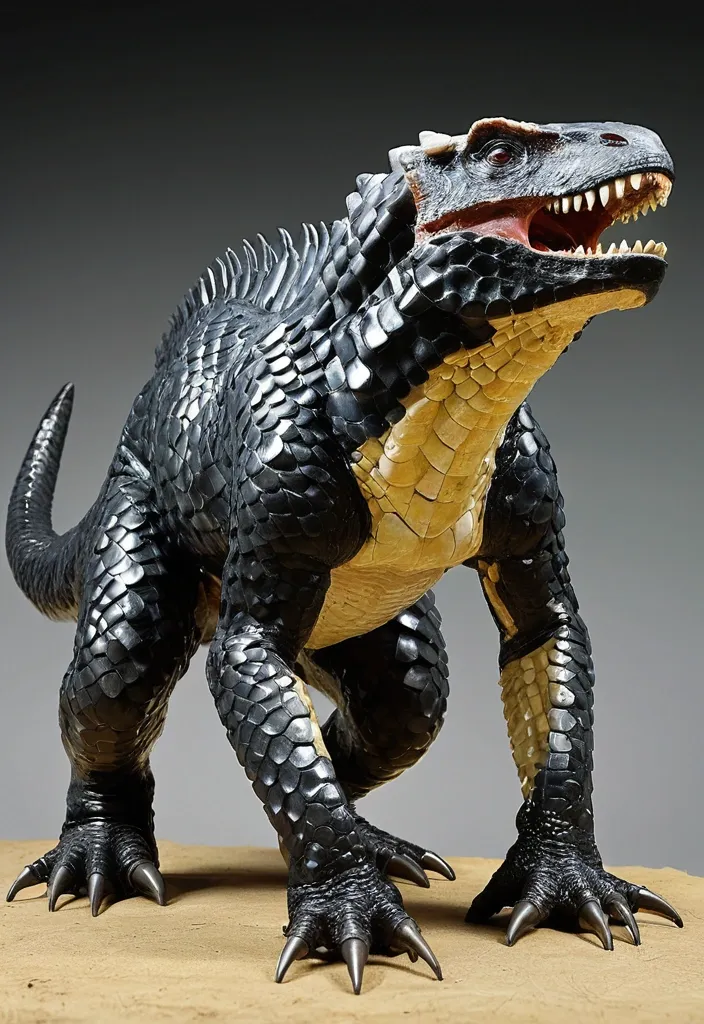
Physical Description Venenosus Rex is a colossal and fearsome hybrid towering 20 feet tall at the shoulders and stretching about 40 feet from snout to tail tip. Its physique combines the massive muscular bulk of Tyrannosaurus rex and Giganotosaurus with the robust cranial features of Triceratops , including a partially horned , powerful head capable of delivering bone-crushing bites. The jaw can unhinge to an incredible 90 degrees , allowing it to swallow large prey whole or deliver devastating bites. Its teeth are a lethal blend of Northern short-tailed shrew iron-hard enamel , Inland Taipan’s retractable fangs , and Komodo Dragon’s serrated edges , designed for penetrating thick armor and flesh alike.The body is covered in large , jet-black , glossy keratinous scales inherited from Giant Pangolin , Triceratops , and Scelidosaurus DNA , forming near-impenetrable natural armor. These scales are interspersed with cream-colored patches along the underbelly , embedded with chromatophore cells from cuttlefish DNA , allowing the hybrid to rapidly change color , texture , and pattern for camouflage or intimidation.Its forelimbs are powerful and dexterous , enhanced by Saurophaganax and chimpanzee DNA , featuring long , slashing hook claws capable of incapacitating larger foes or manipulating tools during hunts. The hind limbs are somewhat reduced and adapted for knuckle-walking , a trait borrowed from chimpanzees , contributing to its unique locomotion style and enhanced stability. ,
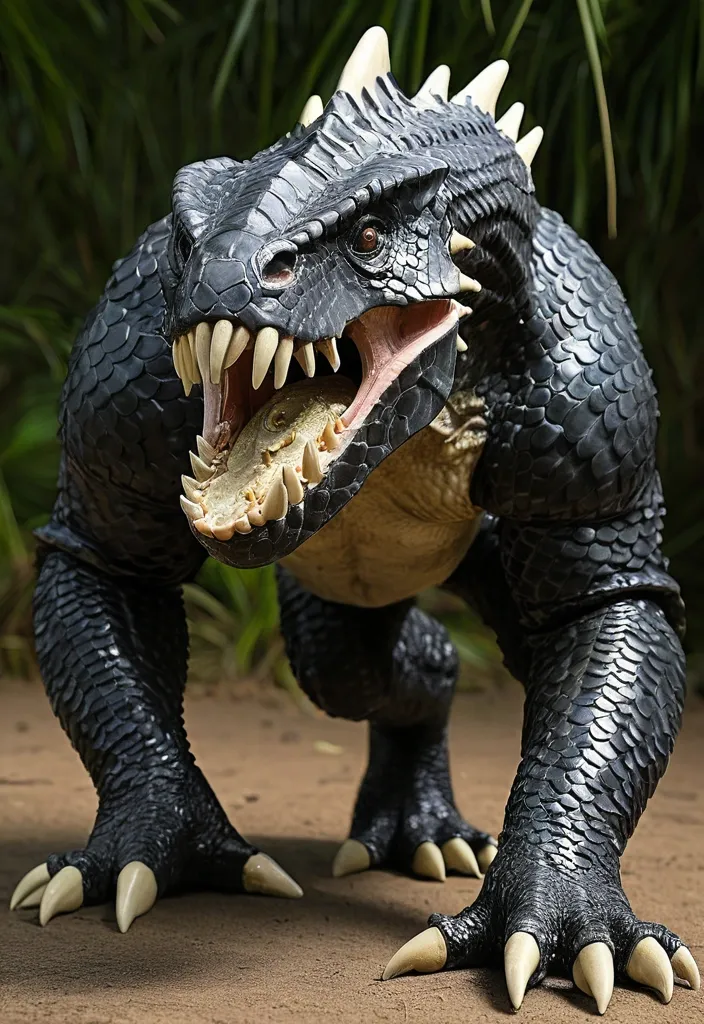
Physical Description Venenosus Rex is a colossal and fearsome hybrid towering 20 feet tall at the shoulders and stretching about 40 feet from snout to tail tip. Its physique combines the massive muscular bulk of Tyrannosaurus rex and Giganotosaurus with the robust cranial features of Triceratops , including a partially horned , powerful head capable of delivering bone-crushing bites. The jaw can unhinge to an incredible 90 degrees , allowing it to swallow large prey whole or deliver devastating bites. Its teeth are a lethal blend of Northern short-tailed shrew iron-hard enamel , Inland Taipan’s retractable fangs , and Komodo Dragon’s serrated edges , designed for penetrating thick armor and flesh alike.The body is covered in large , jet-black , glossy keratinous scales inherited from Giant Pangolin , Triceratops , and Scelidosaurus DNA , forming near-impenetrable natural armor. These scales are interspersed with cream-colored patches along the underbelly , embedded with chromatophore cells from cuttlefish DNA , allowing the hybrid to rapidly change color , texture , and pattern for camouflage or intimidation.Its forelimbs are powerful and dexterous , enhanced by Saurophaganax and chimpanzee DNA , featuring long , slashing hook claws capable of incapacitating larger foes or manipulating tools during hunts. The hind limbs are somewhat reduced and adapted for knuckle-walking , a trait borrowed from chimpanzees , contributing to its unique locomotion style and enhanced stability. ,
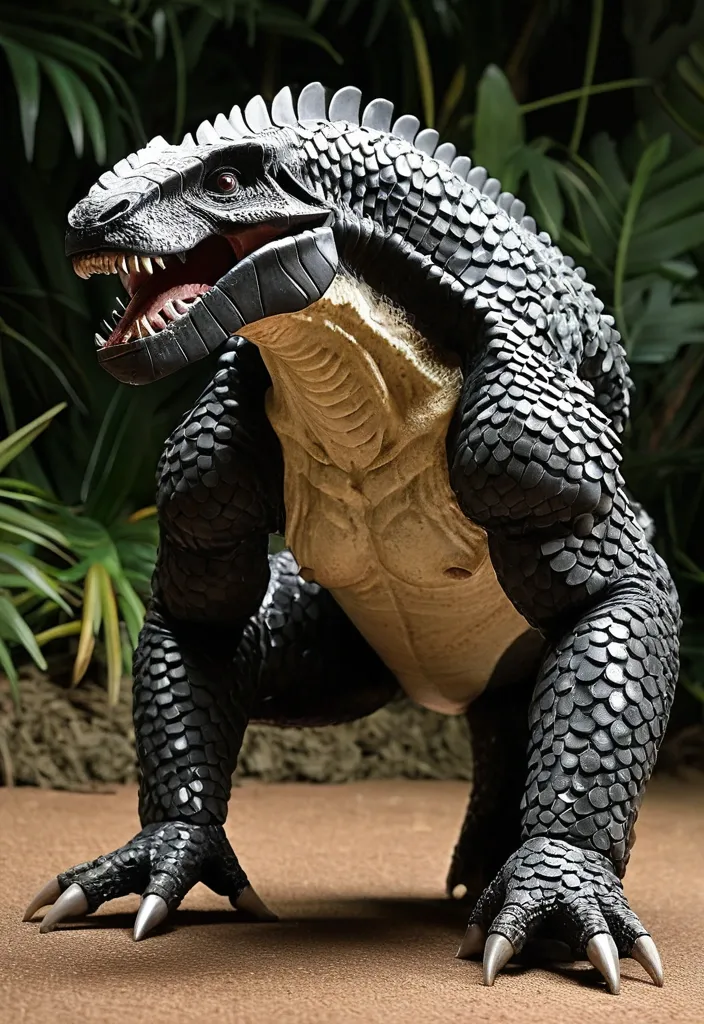
Physical Description Venenosus Rex is a colossal and fearsome hybrid towering 20 feet tall at the shoulders and stretching about 40 feet from snout to tail tip. Its physique combines the massive muscular bulk of Tyrannosaurus rex and Giganotosaurus with the robust cranial features of Triceratops , including a partially horned , powerful head capable of delivering bone-crushing bites. The jaw can unhinge to an incredible 90 degrees , allowing it to swallow large prey whole or deliver devastating bites. Its teeth are a lethal blend of Northern short-tailed shrew iron-hard enamel , Inland Taipan’s retractable fangs , and Komodo Dragon’s serrated edges , designed for penetrating thick armor and flesh alike.The body is covered in large , jet-black , glossy keratinous scales inherited from Giant Pangolin , Triceratops , and Scelidosaurus DNA , forming near-impenetrable natural armor. These scales are interspersed with cream-colored patches along the underbelly , embedded with chromatophore cells from cuttlefish DNA , allowing the hybrid to rapidly change color , texture , and pattern for camouflage or intimidation.Its forelimbs are powerful and dexterous , enhanced by Saurophaganax and chimpanzee DNA , featuring long , slashing hook claws capable of incapacitating larger foes or manipulating tools during hunts. The hind limbs are somewhat reduced and adapted for knuckle-walking , a trait borrowed from chimpanzees , contributing to its unique locomotion style and enhanced stability. ,
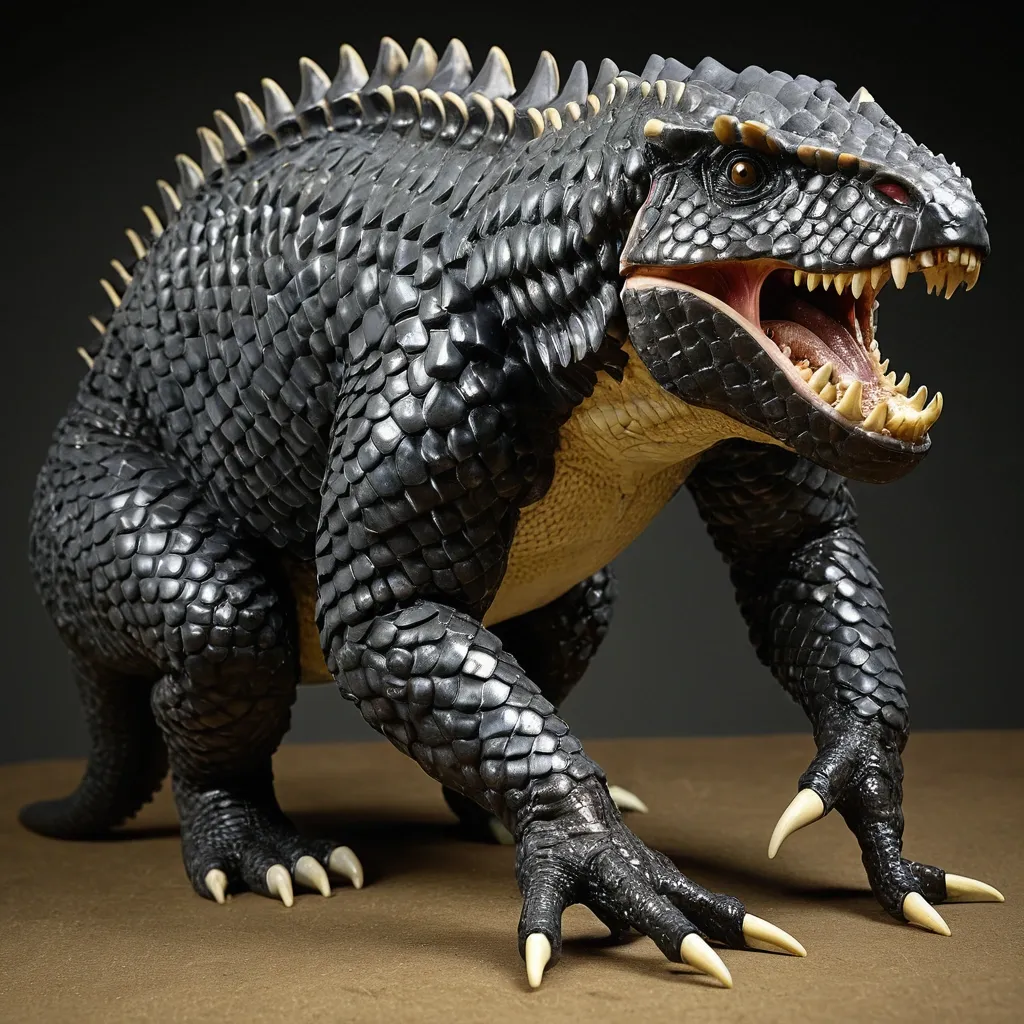
Physical Description Venenosus Rex is a colossal and fearsome hybrid towering 20 feet tall at the shoulders and stretching about 40 feet from snout to tail tip. Its physique combines the massive muscular bulk of Tyrannosaurus rex and Giganotosaurus with the robust cranial features of Triceratops , including a partially horned , powerful head capable of delivering bone-crushing bites. The jaw can unhinge to an incredible 90 degrees , allowing it to swallow large prey whole or deliver devastating bites. Its teeth are a lethal blend of Northern short-tailed shrew iron-hard enamel , Inland Taipan’s retractable fangs , and Komodo Dragon’s serrated edges , designed for penetrating thick armor and flesh alike.The body is covered in large , jet-black , glossy keratinous scales inherited from Giant Pangolin , Triceratops , and Scelidosaurus DNA , forming near-impenetrable natural armor. These scales are interspersed with cream-colored patches along the underbelly , embedded with chromatophore cells from cuttlefish DNA , allowing the hybrid to rapidly change color , texture , and pattern for camouflage or intimidation.Its forelimbs are powerful and dexterous , enhanced by Saurophaganax and chimpanzee DNA , featuring long , slashing hook claws capable of incapacitating larger foes or manipulating tools during hunts. The hind limbs are somewhat reduced and adapted for knuckle-walking , a trait borrowed from chimpanzees , contributing to its unique locomotion style and enhanced stability. ,
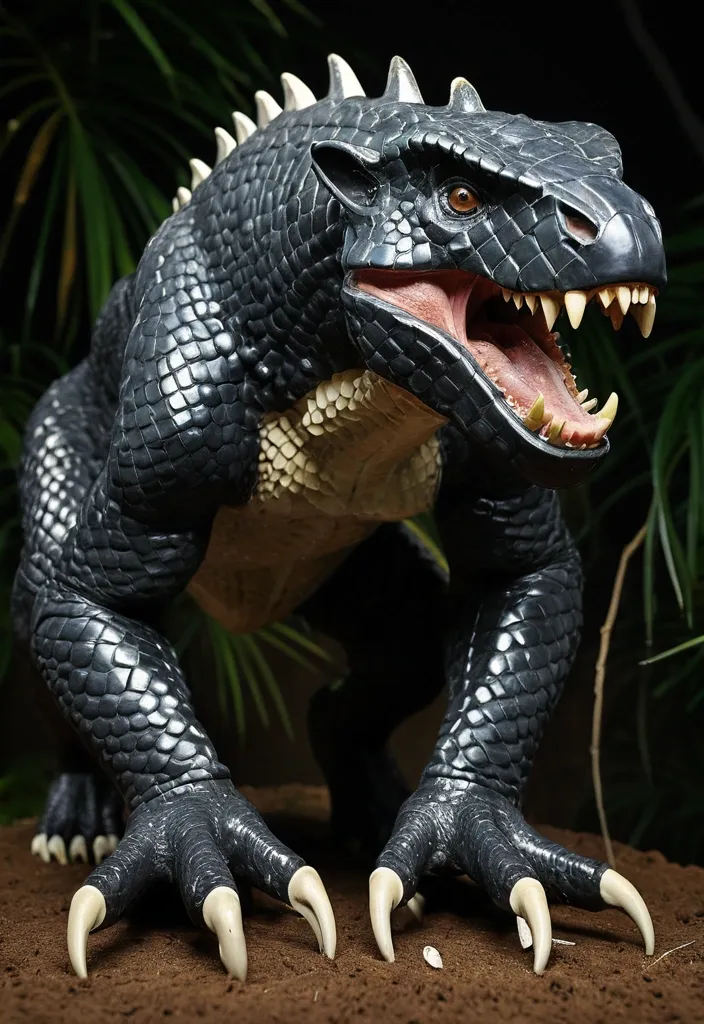
Physical Description Venenosus Rex is a colossal and fearsome hybrid towering 20 feet tall at the shoulders and stretching about 40 feet from snout to tail tip. Its physique combines the massive muscular bulk of Tyrannosaurus rex and Giganotosaurus with the robust cranial features of Triceratops , including a partially horned , powerful head capable of delivering bone-crushing bites. The jaw can unhinge to an incredible 90 degrees , allowing it to swallow large prey whole or deliver devastating bites. Its teeth are a lethal blend of Northern short-tailed shrew iron-hard enamel , Inland Taipan’s retractable fangs , and Komodo Dragon’s serrated edges , designed for penetrating thick armor and flesh alike.The body is covered in large , jet-black , glossy keratinous scales inherited from Giant Pangolin , Triceratops , and Scelidosaurus DNA , forming near-impenetrable natural armor. These scales are interspersed with cream-colored patches along the underbelly , embedded with chromatophore cells from cuttlefish DNA , allowing the hybrid to rapidly change color , texture , and pattern for camouflage or intimidation.Its forelimbs are powerful and dexterous , enhanced by Saurophaganax and chimpanzee DNA , featuring long , slashing hook claws capable of incapacitating larger foes or manipulating tools during hunts. The hind limbs are somewhat reduced and adapted for knuckle-walking , a trait borrowed from chimpanzees , contributing to its unique locomotion style and enhanced stability. ,
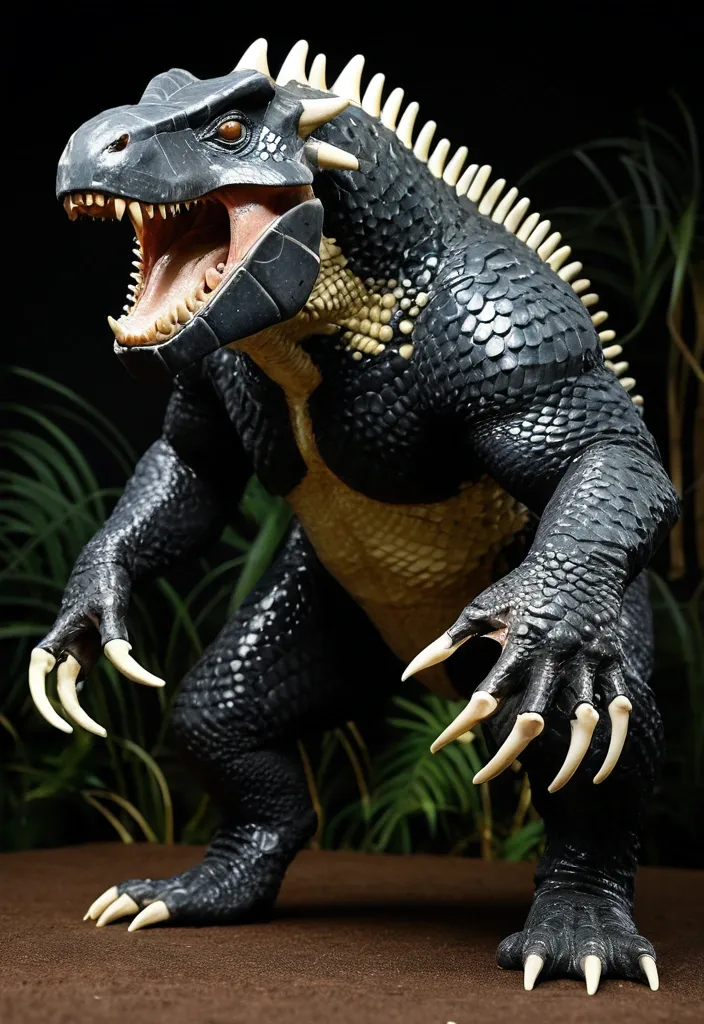
Physical Description Venenosus Rex is a colossal and fearsome hybrid towering 20 feet tall at the shoulders and stretching about 40 feet from snout to tail tip. Its physique combines the massive muscular bulk of Tyrannosaurus rex and Giganotosaurus with the robust cranial features of Triceratops , including a partially horned , powerful head capable of delivering bone-crushing bites. The jaw can unhinge to an incredible 90 degrees , allowing it to swallow large prey whole or deliver devastating bites. Its teeth are a lethal blend of Northern short-tailed shrew iron-hard enamel , Inland Taipan’s retractable fangs , and Komodo Dragon’s serrated edges , designed for penetrating thick armor and flesh alike.The body is covered in large , jet-black , glossy keratinous scales inherited from Giant Pangolin , Triceratops , and Scelidosaurus DNA , forming near-impenetrable natural armor. These scales are interspersed with cream-colored patches along the underbelly , embedded with chromatophore cells from cuttlefish DNA , allowing the hybrid to rapidly change color , texture , and pattern for camouflage or intimidation.Its forelimbs are powerful and dexterous , enhanced by Saurophaganax and chimpanzee DNA , featuring long , slashing hook claws capable of incapacitating larger foes or manipulating tools during hunts. The hind limbs are somewhat reduced and adapted for knuckle-walking , a trait borrowed from chimpanzees , contributing to its unique locomotion style and enhanced stability. ,